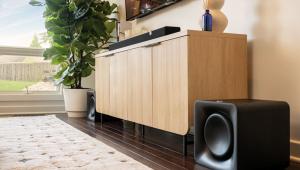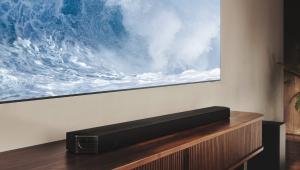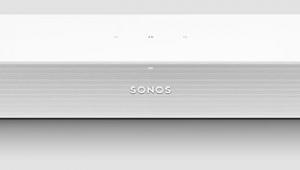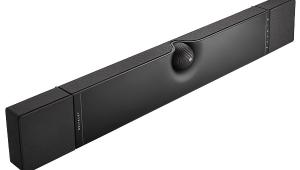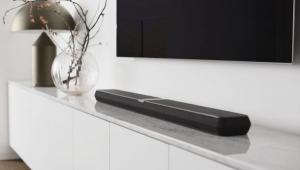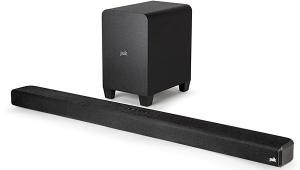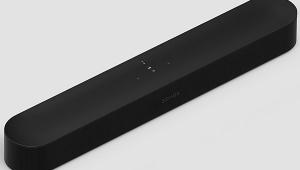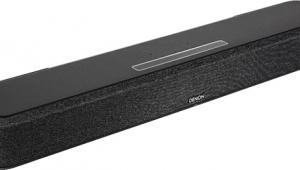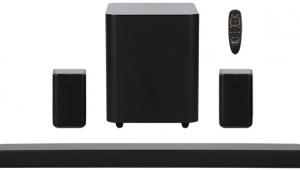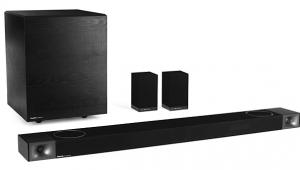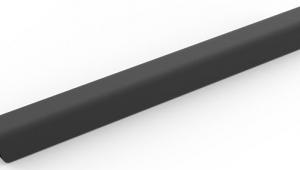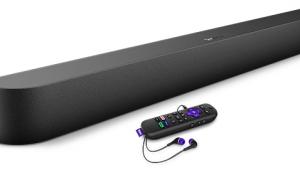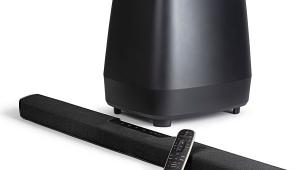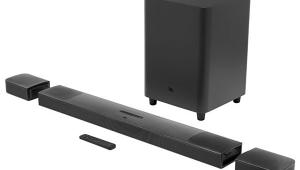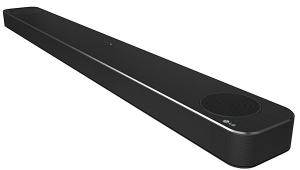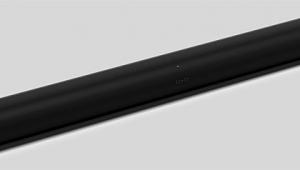This seems like a great device...but is not very useful with only one audio input. I have a cable box, blu-ray and Firebox hooked up...all would need audio inputs to make this work.
Sonos Playbase Review Page 2
There are only a few useradjustable settings (which are only accessible through the app), such as bass and treble up/down and loudness compensation on/off. There are also on/off settings for Dialogue Enhancement (it adds emphasis to bring dialogue more to the front of the soundstage) and Night Mode (it limits the system’s dynamic range). If you add a Sonos Sub, there’s a volume level adjustment in the app for it. And if you add a set of Play:1 (or Play:3 or Play:5) speakers for surrounds, you can adjust the surround effect level for TV and Music, as well as the amount of ambience present in the rear speakers.
So, WTF? How do you adjust time delays and channel output levels? And mode settings for sources, and all that other fun stuff? The quick answer is: You don’t. (Wasn’t that easy?) The longer answer is: You don’t because the Playbase uses Sonos’ Trueplay technology and the microphone in your iOS device (sorry, no Android support) to automatically adjust each individual driver in the speaker, to make it perform as close as possible to the reference, taking into account the room’s acoustics and the speaker’s placement. It’s a truly amazing technology that has been around for a year or two, and I’m stilled awed every time I use it to set up any Sonos speaker in my house. Even more amazing is that Trueplay will calculate all the individual adjustments as needed if you add a Sonos Sub or a pair of Play speakers for surrounds.
Wrap Your Head Around This
After I finally took a break from marveling at how compact the Playbase is, I started watching Episode 9 (“Blackwater”) from Season 2 of Game of Thrones— and quickly began marveling at how big the sound was. The dialogue was very clear and distinct from the music behind it, while the soundstage was damn impressive.
The opening of the episode starts with Stanis’ ship sailing towards King’s Landing at night on rough seas. I didn’t hear any surround effects of the waves or the rain coming from behind my head, nor would I expect to, but the surround field organically wrapped itself around the front half of the room until it ended up embracing my ears. Later in the episode, as a large part of Stanis’ fleet is being immolated by Tyrion’s wildfire, there was even a time when it seemed as if the sound of flying debris actually did originate from slightly behind me. In terms of rear-soundfield extension, Playbase was equal to or—in most cases—better than any of the other singlecabinet, faux-five-channel soundbars I’ve listened to.
Meanwhile, the bass coming out of the relatively tiny Playbase was, well, surprising. Soundbars in general are pretty miserly with their low-frequency output, and only the largest and bulkiest soundbases can usually manage any truly extended bass. So I’ll admit to not having much in the way of expectations from the squatty Playbase. After all, as I’ve said many a time, there’s only so much you can do with 2.28 inches. On the other hand, if there’s such a thing as bassViagra for medium-size woofers, the Sonos engineers must have added a double dose to the modest, horizontally mounted 5.25-inch driver in the Playbase. The drumbeats and explosions during the wildfire devastation in Game of Thrones were taut and full, and the Playbase’s cabinet never issued any audible resonance or chuffing noise coming from its waveguide and flared port. The lowend output certainly wasn’t equivalent to what you’d get from having a decent, powered subwoofer in the room, but the bass performance was definitely powerful and present—and amazingly prodigious from such a small cabinet—even in my goodsized (12 x 24-foot) theater room.
Nocturnal Animals isn’t an action movie—at least, not in the sense of “action” that we usually associate with movies. But there’s a notable amount of subtle action in the soundtrack that showed how well the Playbase was able to handle the placement of small details. One scene involves a man walking through some West Texas brush, looking for his abducted wife and daughter. (It never ends well when “West Texas” and “abducted” are in the same sentence.) The scene is eerily quiet except for the barest wisps of a breeze and the noise of insects, and the Playbase’s ability to wrap the sound of that desolate landscape around me was pure artistry. It was similarly impressive with the opening of Allied, where the camera follows a man parachuting through the sky until he finally lands in the desert sand. The flapping of the fabric and the squeaking sounds from his gear were well defined in the center, without any constriction, while the open air around him had amazing width across the room.

I added in a pair of Sonos Play:1 speakers ($199 each) as rear surrounds to gauge the effect. The best way I can describe it is to say it was akin to removing a wall from behind my head. Effects that were present at the sides with the Playbase on its own were now clearly coming from the rear. If you think of the sound from the Playbase as a semicircle in front, the Play:1s simply completed the circle, and in a seamless manner that made it impossible to tell where the transition occurred. Critically, there was no detectable difference in the tonal balance from front to rear. In the opening scene of the Game of Thrones episode mentioned earlier, for example, the sound of the falling rain comes from everywhere once the Play:1s are joined to the system, and splashes of waves can also be heard from directly behind the listener.
As impressive as I found the bass from the Playbase on its own, integrating a Sonos Sub to the system (either with or without the Play:1 speakers) obviously brought the hammer down, adding substantial bass response below 50 hertz where the Playbase began running out of gas in my room. Perhaps even more impactful, though, were the other effects it had on the sonic character of the Playbase. First off, the midbass range that the Playbase had previously handled fairly well by itself became tighter and quicker. Beyond that, I also noticed an overall increase in the clarity of sound. Dialogue became more focused and forward, while the width, depth, and height of the soundstage seemed to expand and grow. Ian from Sonos explained that dropping the Sub into the system not only reduces the work required from the 5.25-inch bass driver in the Playbase, but also allows the system to offload some of the processing power to the Sub. Essentially, the electronics and amplification of the Playbase become more efficient, and you can really hear it.
Tunes Time
The more I listened to twochannel music through the Playbase (unaccompanied by surrounds or Sub), the more it grew on me. The Playbase doesn’t deliver that determinedly focused sound that you’d hear from a good pair of discrete speakers, but it has a width and spaciousness that’s incredibly appealing. Older recordings, such as Gordon Macrea’s “Oh What a Beautiful Morning” from Oklahoma, had a wonderful openness without any lingering, echoey processing artifacts. With newer tracks, for example, Robbie Williams’ version of “I Wan’na Be Like You” (featuring Olly Murs) and Sun Ra’s “A Call for All Demons,” the soundstage opened up even more to help fill the room in front of me. And there seemed little lacking with the bass response in the fast-paced “Primadonna Girl” from Marina and the Diamonds.
On its own, the Playbase doesn’t offer traditional soundfield adjustments. (Remember, that’s part of the simplicity appeal.) Nonetheless, the Sonos app does allow for a few tweaks when you add a pair of rear speakers (like the Play:1s I used). With surround speakers turned on, the only adjustment available for audio through the optical input is “TV Level,” which is basically the volume level of the rear speakers. Audio streamed to the Playbase via your home network, however, allows access to a “Music Level” slider adjustment with “Music Playback” settings of “Ambient” or “Full.” It was somewhat difficult to tell, but TV Level and Ambient Music Playback processing seemed to have virtually the same results. Much as with my 5.1 movie surround experience from the Playbase, two-channel music with the surrounds and the Ambient processing engaged wrapped around the walls towards the rear of the room.

The soundfield did not, however, form a complete circle around me, which kept the music-listening experience feeling very natural rather than contrived. With everything going on in “Primadonna Girl,” for instance, the ambience extended back along the sides before finally and gently fading away. As happened with movie soundtracks, the front remained unchanged, except for the fact that it now seamlessly blended well into the sides of the listening space. Activating the Full option under Music Playback was less desirable; it was much more like an All-Channel Stereo mode you might hear on an A/V receiver. In the case of “Primadonna Girl,” it actually caused the rear Play:1s to sound louder than the Playbase. While I didn’t find that an especially enjoyable listening experience, it’s easy enough to simply not use it. You might feel otherwise.
As happened with movies, adding the Sub to the Playbase (with or without the Play:1s and regardless of any surround mode settings) provided obviously deeper bass for music. The track “Islands”, from The xx’s debut album xx, has a wickedly low, wobbly bass note that hits at several points in the song. Unassisted, the Playbase did an admirable job of reproducing the note, and importantly, its woofer didn’t break up or bottom out—a testament to the combination of driver design and digital signal processing. But it took the addition of the Sub and its below-50-Hz bass juice for me to start feeling a bit of fear creeping into my bowels. There were also the same previously heard benefits of increased punch in the midbass and the expanded width and clarity of the front soundstage. Similar beneficial midbass and soundstage effects were heard on “Primadonna Girl,” although the bass on that track doesn’t go quite as low.
Conclusion
The TV soundbase, while building a small niche for itself over several years, has yet to set the world on fire, with sales that are undoubtedly minuscule compared with soundbars. Sonos argues that it’s not the soundbase form factor that’s prevented it from catching on; rather, with so few TV owners actually hanging their sets, the market should support far greater sales. It’s Sonos’ view that the execution of most soundbase products just hasn’t fulfilled all the proper requirements to date: Robust soundbases that might offer deeper bass and better-quality sound have required a cabinet that’s inevitably too large and bulky for most consumers, and smaller, thinner soundbases have typically failed to deliver the kind of low-end performance that makes them a suitable standalone solution. And none of them, of course, can function as the heart of an engaging, expandable wireless multiroom music system.
With that in mind, the Sonos Playbase offers amazing home theater sound performance—including a mind-blowing amount of solid bass—from an elegant (but not likely to be noticed) 2.28-inch-tall enclosure that will fit quite nicely on most furniture. It works so simply and automatically while blending in with the TV and associated accouterments that you’ll forget it’s there. That’s a nearly unheard-of feat for a piece of A/V gear to accomplish. As a result, I think the Playbase is darn near worth the $699 price tag solely on the basis of its inherent simplicity and subtle beauty—and that’s before considering the sound quality.
You can also reverse that sentiment and justify the price for the sound quality alone without taking a gander at the Playbase’s seemingly hewn-from-a-single-piece-of-granite exquisiteness. When you add the multiroom system capabilities and built-in streaming services, the value quotient just goes up. Then, throw in the super-easy ability to expand the system with a subwoofer and surrounds. In total, the Playbase isn’t just a TV sound system—it’s a platform for making entertainment and music a big part of your life, but without taking away anything from your aesthetics or anything else. That makes for a pretty big recommendation for a pretty unassuming box.
- Log in or register to post comments



I agree with you ...but I think they have limited (probably purposefully) their potential customer base. ...I have optical outs on my various devices, but not on the tv

The scoring for all the Sonos soundbars on here are inflated -- they should receive 3 stars for Features, not 4.5 stars. How can they get 4.5 stars when they do not support DTS of any kind, Atmos, HDMI inputs, HD/hires audio, and other features I can't think of right now?
